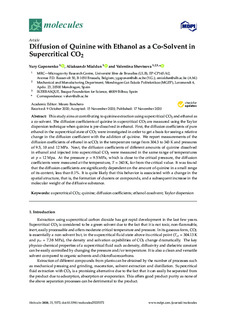Izenburua
Diffusion of Quinine with Ethanol as a Co-Solvent in Supercritical CO2Egilea
Beste erakundeak
Université Libre de BruxellesIkerbasque
Bertsioa
Bertsio argitaratuaDokumentu-mota
ArtikuluaArtikuluaHizkuntza
engEskubideak
© 2020 by the authors. Licensee MDPISarbidea
Sarbide irekiaArgitaratzailearen bertsioa
https://doi.org/10.3390/molecules25225372Non argitaratua
Molecules Vol. 25. N. 22. N. artículo 5372, 2020Argitaratzailea
MDPIGako-hitzak
supercritical CO2
quinine
diffusion coefficients
ethanol cosolvent ... [+]
quinine
diffusion coefficients
ethanol cosolvent ... [+]
supercritical CO2
quinine
diffusion coefficients
ethanol cosolvent
Taylor dispersion [-]
quinine
diffusion coefficients
ethanol cosolvent
Taylor dispersion [-]
Laburpena
This study aims at contributing to quinine extraction using supercritical CO2 and ethanol as a co-solvent. The diffusion coefficients of quinine in supercritical CO2 are measured using the Taylor disp ... [+]
This study aims at contributing to quinine extraction using supercritical CO2 and ethanol as a co-solvent. The diffusion coefficients of quinine in supercritical CO2 are measured using the Taylor dispersion technique when quinine is pre-dissolved in ethanol. First, the diffusion coefficients of pure ethanol in the supercritical state of CO2 were investigated in order to get a basis for seeing a relative change in the diffusion coefficient with the addition of quinine. We report measurements of the diffusion coefficients of ethanol in scCO2 in the temperature range from 304.3 to 343 K and pressures of 9.5, 10 and 12 MPa. Next, the diffusion coefficients of different amounts of quinine dissolved in ethanol and injected into supercritical CO2 were measured in the same range of temperatures at p = 12 Mpa. At the pressure p = 9.5 MPa, which is close to the critical pressure, the diffusion coefficients were measured at the temperature, T = 343 K, far from the critical value. It was found that the diffusion coefficients are significantly dependent on the amount of quinine in a small range of its content, less than 0.1%. It is quite likely that this behavior is associated with a change in the spatial structure, that is, the formation of clusters or compounds, and a subsequent increase in the molecular weight of the diffusive substance. [-]
Bildumak
Item honek honako baimen-fitxategi hauek dauzka asoziatuta:






















